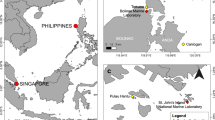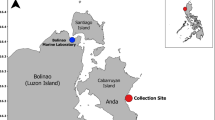Abstract
In a study of seven massive, Caribbean corals, I have found major differences in reproductive behavior between species with large maximum colony sizes and species with smaller maximum colony sizes. Four species (Diploria clivosa, D. strigosa, Montastrea cavernosa, Siderastrea siderea) which are large (<1000 cm2 in surface area) broadcast gametes during a short spawning season. Their puberty size is relatively large (>100 cm2, except M. cavernosa). In contrast, two small massive species (<100 cm2, Favia fragum and S. radians), and one medium-sized (100–1000 cm2, Porites astreoides) massive species, brood larvae during an extended season (year-round in Panama). The puberty size of the small species is only 2–4 cm2. Given these close associations between maximum colony sizes and a number of fundamental reproductive attributes, greater attention should be given to the colony size distributions of different species of reef corals in nature, since many important life history and population characters may be inferred.
Similar content being viewed by others
References
Babcock RC (1984) Reproduction and distribution of two species of Goniastrea (Scleractinia) from the Great Barrier Province. Coral Reefs 2:187–195
Babcock RC (1991) Comparative demography of three species of scleractinian corals using age- and size-dependent classifications. Ecol Monogr 61:225–244
Bak RPM, Engel MS (1979) Distribution, abundance and survival of juvenile hermatypic corals (Scleractinia) and the importance of life history strategies in the parent coral community. Mar Biol 54:341–352
Begon M (1985) A general theory of life-history variation. In: Sibly RM, Smith RH (eds) Behavioral ecology. Blackwell Scientific Publication, London, pp 91–97
Blueweiss L, Fox H, Kudzma V, Nakashima D, Porters R, Sams S (1979) Relationships between body size and some life history characters. Oecologia 37:257–272
Buss LW (1980) Competitive intransitivity and size-frequency distributions of interacting populations. Proc Natl Acad Sci USA 77:5355–5359
Calder WAI (1984) Size, function, and life history. Harvard University Press, Cambridge
Caswell H (1985) The evolutionary demography of clonal reproduction. In: Jackson JBC, Buss LW, Cook RE (eds) Population biology and evolution of clonal organisms. Yale University Press, New Haven, pp 187–224
Caswell H (1988) Approaching size and age in matrix population models. In: Ebenman B, Persson L (eds) Size-structured populations-ecology and evolution. Springer Berlin Heidelburg New York, pp 85–105
Chia FS (1968) Some observations on the development and cyclic changes of the oocytes in a brooding starfish, Leptasterias hexactis. J Zool 154:453–461
Charnov EL (1979) Simultaneous hermaphroditism and sexual selection. Proc Natl Acad Sci USA 76:2480–2484
Connell JE (1973) Population ecology of reef building corals. In: Jones OA, Endean R (eds) Biology and geology of coral reefs, vol 2. Academic Press, London, pp 205–245
Diaconis P, Efron B (1983) Computer intensive methods in statistics. Sci Am 248(5):116–130
Ebenman B, Persson L (1988) Size-structured populations — ecology and evolution. Springer, Berlin Heidelberg New York
Fadlallah YH, Pearse JS (1982) Sexual reproduction in solitary corals: overlapping oogenic and brooding cycles, and benthic planulae in Balanophyllia elegans. Mar Biol 71:223–231
Fitzhardinge R (1985) Spatial and temporal variability in coral recruitment in Kaneohe Bay (Oahu, Hawaii). Proc 5th Int Coral Reef Cong 4:373–378
Gallardo CS (1977) Two modes of development in the morphospecies Crepidula dilatata (Gastropoda: Calyptraeidae) from southern Chile. Mar Biol 39:241–251
Harriott VJ (1983) Reproductive ecology of four scleractinian species at Lizard Island, Great Barrier Reef. Coral Reefs 2:9–18
Harrison PL, Wallace CC (1990) Reproduction, dispersal and recruitment of scleractinian corals. In: Dubinsky Z (ed) Ecosystems of the world, vol 25: Coral reefs. Elsevier, New York, pp 133–207
Highsmith RC (1979) Coral growth rates and environmental control of density banding. J Exp Mar Biol Ecol 37:105–125
Highsmith RC (1982) Reproduction by fragmentation in corals. Mar Ecol Prog Ser 7:207–226
Highsmith RC, Riggs AC, D'Antonio CM (1980) Survival of hurricane-generated coral fragments and a disturbance model of reef calcification growth rates. Oecologia 46:322–329
Holloran MK (1986) The relationship between colony size and larva production in the reef coral Pocillopora damicornis. In: Jokiel DJ, Richmond RH, Rogers CL (eds) Coral reef population biology, vol 37. Hawaiian Institute of Marine Science, Hawaii, pp 167–169
Hudson JH (1985) Long-term growth rates of Porites lutea before and after nuclear testing: Enewetak Atoll (Marshall Islands). Proc 5th Int Coral Reef Symp 6:179–185
Hughes RN, Cancino JM (1985) An ecological overview of cloning in metazoa. In: Jackson JBC, Buss LW, Cook RE (eds) Population biology and evolution of clonal organisms. Yale University Press, New Haven, pp 153–186
Hughes TP (1984) Population dynamics based on individual size rather than age: a general model with a reef coral example. Am Nat 123:778–95
Hughes TP, Connell JH (1987) Population dynamics based on size or age? A reef-coral analysis. Am Nat 129:818–829
Hughes TP, Jackson JBC (1980) Do corals lie about their age? Some demographic consequences of partial mortality, fission, and fussion. Science 209:713–715
Hughes TP, Jackson JBC (1985) Population dynamics and the life histories of foliaceous corals. Ecol Monogr 55:141–166
Jackson JBC, Coates AG (1986) Life cycles and evolution of clonal (modular) animals. Philos Trans R Soc Lond Ser B 313:7–22
Kojis BL, Quinn NJ (1982) Reproductive strategies in four species of Porites (Scleractinia). Proc 4th Int Coral Reef Symp 2:145–151
Kojis BL, Quinn NJ (1985) Puberty in Goniastrea favulus, age or size limited? Proc 5th Int Coral Reef Symp 4:289–294
Lang JC, Chornesky EA (1990) Competition between reef corals: a review of mechanisms and effect. In: Dubinsky Z (ed) Ecosystems of the world, vol 25: Coral reefs. Elsevier, New York, pp 209–252
Menge BA (1975) Brood or broadcast? The adaptive significance of different reproductive strategies in the two intertidal sea stars Leptasterias hexactis and Pisaster ochraceus. Mar Biol 31: 87–100
Mood AM, Graybill FA, Boes DC (1974) Introduction to the theory of statistics, 3rd edn. McGraw Hill, New York
Newell ND (1949) Phyletic size increase—an important trend illustrated by fossil invertebrates. Evolution 3:103–124
Olive PJW (1985) Covariability of reproductive traits in marine invertebrates: implications for the phylogeny of the lower invertebrates. In: Morris C, George JD, Gibson R, Platt HM (eds) The origins and relationship of lower invertebrates. Clarendon, Oxford, pp 42–59
Peters RH (1983) The ecological implications of body size. Harvard University Press, Cambridge
Potts DC (1984a) Generation times and the quaternary evolution of reef-building corals. Paleobiology 10:48–58
Potts DC (1984b) Evolutionary disequilibrium among Indo_Pacific corals. Bull Mar Sci 33:619–632
Richmond RH, Hunter CL (1990) Reproduction and recruitment of corals: comparisons among the Caribbean, the tropical Pacific, and the Red Sea. mar Ecol Prog Ser 60:185–203
Rinkevich B, Loya Y (1979) The reproduction of the Red Sea coral Stylophora pistillata, I. Gonads and planulae. Mar Ecol Prog Ser 1:145–152
Rinkevich B, Loya Y (1986) Senescence and dying signals in a reef building coral. Experiencia 42:320–322
Rogers CS, Fitz HCI, Gilnack M, Beets J, Hardin J (1984) Scleractinian coral recruitment patterns at Salt River submarine canyon, St Croix, US Virgin Islands. Coral Reefs 3:69–76
Rylaarsdam KW (1980) Life histories and abundance patterns of some common Caribbean reef corals. PhD dissertation. John Hopkins University, Baltimore, Md
Schaffer WM (1974) Selection for optimal life-histories: effects of age structure. Ecology 55:291–303
Schaffer WM, Gadgil M (1975) Selection for optimal life histories in plants. In: Cody ML, Diamond JE (eds) Ecology and evolution of communities. Belknap, Cambridge, pp 142–157
Sebens KP (1987) The ecology of indeterminate growth in animals. Annu Rev Ecol Syst 18:371–407
Soong K (1990) Reproduction of colonial reef corals: individuality of coral colonies and colony size related characters. PhD dissertation. University of Texas
Soong K (1991) Sexual reproductive patterns of shallow-water reef corals in Panama. Bull Mar Sci 49(3):832–846
Stimson JS (1978) Mode and timing of reproduction in some common hermatypic corals of Hawaii and Enewetak. Mar Biol 48:173–184
Strathmann RR, Strathmann MF (1982) The relationship between adult size and brooding in marine invertebrates. Am Nat 119:91–101
Szmant AM (1986) Reproductive ecology of Caribbean reef corals. Coral Reefs 5:43–54
Szmant-Froelich A (1985) The effect of colony size on the reproductive ability of the Caribbean coral Montastrea annularis (Ellis and Solander). Proc 5th Int Coral Reef Symp 4:295–300
Vaughan TW (1915) Growth rate of the Floridian and Bahamian shoal-water corals. Carnegie Inst Year Book 14:221–31
Veron JEN (1986) Corals of Australia and the Indo-Pacific. Angus and Robertson Publishers, London
Veron JEN, Pichon M (1982) Scleractinia of Eastern Australia. Part IV. Poritidae. Aust Inst Mar Sci Monogr Ser 5:1–159
Wallace CC (1985) Reproduction, recruitment and fragmentation in nine sympatric species of the coral genus Acropora. Mar Biol 88:217–33
Werner EE, Gilliam JF (1984) The ontogenetic niche and species interactions in size-structured populations. Annu Rev Ecol Syst 15:393–425
Williams GC (1975) Sex and evolution. Princeton University Press, Princeton, NJ
Wright N (1986) Aspects of reproduction and planula development in the reef coral Cyphastrea ocellina. In: Jokiel DJ, Richmond RH, Rogers CL (eds) Coral reef population biology, vol 37. Hawaiian Institute of Marine Science, Hawaii, pp 179–192
Author information
Authors and Affiliations
Rights and permissions
About this article
Cite this article
Soong, K. Colony size as a species character in massive reef corals. Coral Reefs 12, 77–83 (1993). https://doi.org/10.1007/BF00302106
Accepted:
Issue Date:
DOI: https://doi.org/10.1007/BF00302106




